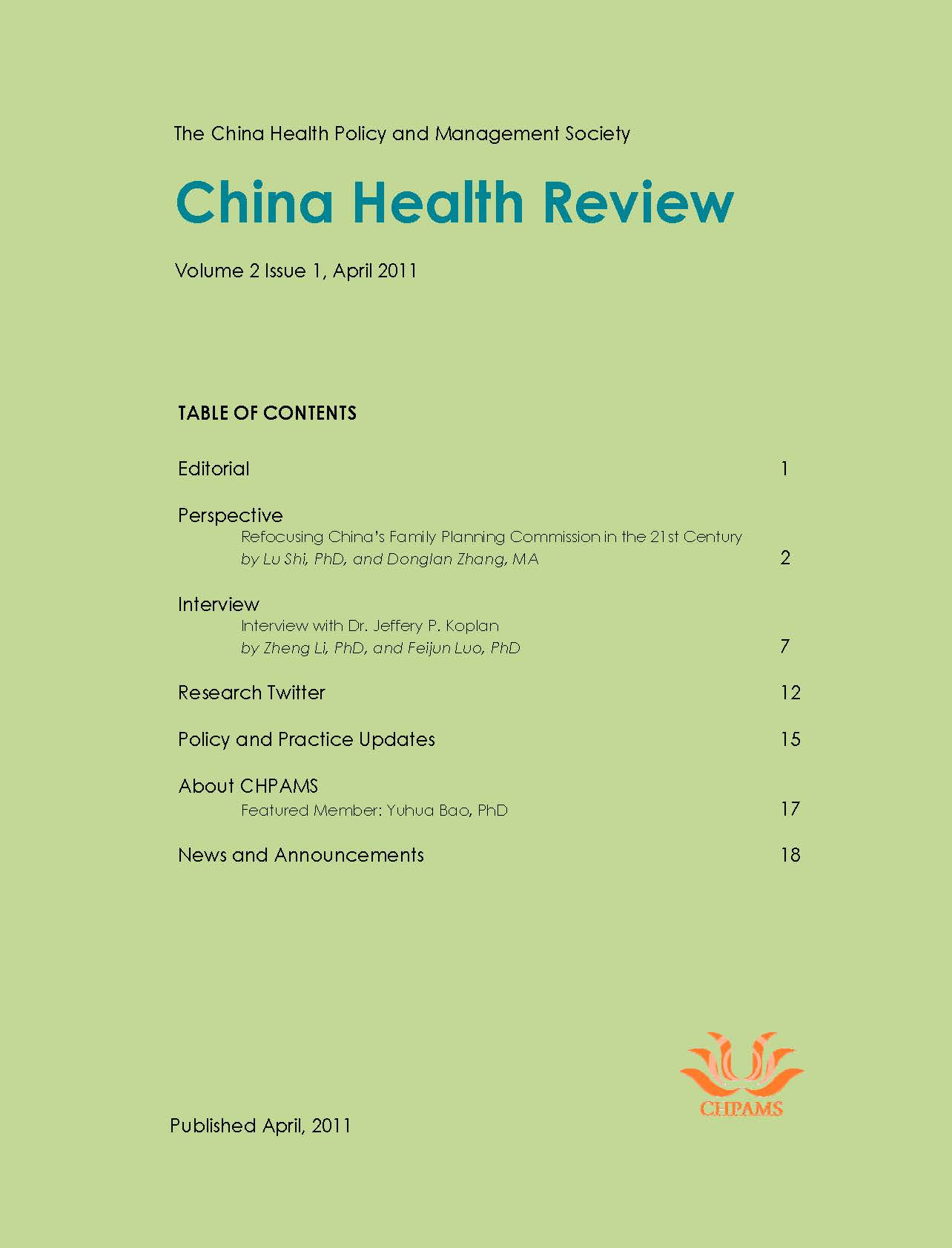Refocusing China’s Family Planning Commission in the 21st Century
Keywords:
Family planning, China, health and human servicesAbstract
China’s entry into an aging society calls for a transition of its population policy. The State Family Planning Commission (SFPC) could concentrate more on many essential health and human services for the next few decades. Prevention of birth defects and reduction of unnecessary cesarean births are cost-effective interventions that would enhance the health of the upcoming generations. Research and evaluation of modern contraceptive technologies are needed to promote reproductive health and help both the SFPC and users make well-informed decisions. Human Immunodeficiency Virus (HIV) and Sexually Transmitted Diseases (STD) testing and counseling deserve the joint efforts of the government, health services, and the society at large. Further, the SFPC’s collaboration with the Ministry of Health, Ministry of Agriculture and the National Women’s Federation can help to reinforce its role in the treatment of infertility and maternal diseases, the provision of public services for low-income families, and the prevention of domestic violence. The SFPC can also play a role in China’s increasing foreign aid, particularly in those countries where artificial contraception and HIV/STD prevention are needed.References
Bird TM, Bronstein JM, Hall RW, et al. Late Preterm Infants: Birth Outcomes and Health Care Utilization in the First Year. Pediatrics. 2010; 126(2):e311-319.
Bogg L, Huang K, Long Q, Shen Y, Hemminki E. Dramatic increase of Cesarean deliveries in the midst of health reforms in rural China. Social Science & Medicine. 2010; 70(10):1544-1549.
Chen F, Liu G. Population Aging in China. In: International Handbook of Population Aging, Peter Uhlenberg (editor), 2009. Springer Publishers, New York, pp. 157-172.
Chen Y, Chen J, Qian X, Xue D. Cost-effectiveness analysis on periconceptional folic acid supplementation for neural tube defects. China Health Resources. 2007 March(3).
China Radio Broadcasting Net. The Education Ministry Attributes the Decline in College Entrance Exam Registration to the Decline in High School Graduates. Accessed on October 31, 2010 at http://www.xixik.com/content/49a25ad6dae77d4e.
De-Regil LM, Fernández-Gaxiola AC, Dowswell T, Peña-Rosas JP. Effects and safety of periconceptional folate supplementation for preventing birth defects. Cochrane Database Syst Rev. 2010;10:CD007950.
Hesketh T, Lu L, Xing ZW. The Effect of China's One-Child Family Policy after 25 Years. New England Journal of Medicine. 2005; 353(11):1171-1176.
Hutchinson PL, Mahlalela X, Yukich J. Mass media, stigma, and disclosure of HIV test results: multilevel analysis in the Eastern Cape, South Africa. AIDS Educ Prev. 2007; 19(6):489-510.
Hvistendahl M. Has China Outgrown The One-Child Policy? Science. 2010;329(5998):1458-1461.
Leung GM, Lam T, Thach TQ, Wan S, Ho L. Rates of Cesarean Births in Hong Kong: 1987–1999. Birth. 2001; 28(3):166-172.
Morgan SP, Zhigang G, Hayford SR. China's Below-Replacement Fertility: Recent Trends and Future Prospects. Population and Development Review. 2009; 35(3):605-629.
Parish WL, Laumann EO, Mojola SA. Sexual Behavior in China: Trends and Comparisons. Population and Development Review. 2007; 33(4):729-756.
Poston DL, Zhang L. China’s Unbalanced Sex Ratio at Birth: How Many Surplus Boys Have Been Born in China since the 1980s? In: Gender Policy and HIV in China. Vol.22. The Springer Series on Demographic Methods and Population Analysis. Springer Netherlands; 2009: 57-69. Available at: http://dx.doi.org/10.1007/978-1-4020-9900-7_4.
Rush D, Sloan N, Leighton J, et al. The National WIC Evaluation: evaluation of the Special Supplemental Food Program for Women, Infants, and Children. V. Longitudinal study of pregnant women. The American Journal of Clinical Nutrition. 1988; 48(2):439 -483.
Rush D, Leighton J, Sloan N, et al. The National WIC Evaluation: evaluation of the Special Supplemental Food Program for Women, Infants, and Children. VI. Study of infants and children. The American Journal of Clinical Nutrition. 1988; 8(2):484 -511.
Sharma A, Congdon N, Gao Y, et al. Height, Stunting, and Refractive Error Among Rural Chinese Schoolchildren: The See Well to Learn Well Project. American Journal of Ophthalmology. 2010; 149(2):347-353.e1.
Su X, Miao M, et al. A Meta-analysis of Birth Defect Prevalence before and after the abolition of Mandatory Premarital Screening. (强制婚检取消前后出生缺陷发生率Meta分析). Chinese Journal of Public Health. 中国公共卫生, 2008; 24(12).
Toby L. Schonfeld; Bruce G. Gordon. Contraception in Research: A Policy Suggestion. Ethics and Human Research. 2005; 27(2): 15-20.
Xu X, Zhu F, O'Campo P, et al. Prevalence of and Risk Factors for Intimate Partner Violence in China. Am J Public Health. 2005; 95(1):78-85.
Zeng, Y. Options for Fertility Policy Transition in China. Population and Development Review. 2007;33(2):215-246.
Zhang D, United Nations Population Fund. Cost-benefit analysis on switching stainless steel to copper Intra-Uterine Devices in China. Chinese Journal of Family Planing. 1993; 1:23-28.
Zhang T, Wang F, Lin LM, Song XM, Chen G, Gu X, Wu LH, Zheng XY. Occurrence of structural birth defect in high-prevalent areas of China][Article in Chinese] Zhonghua Liu Xing Bing Xue Za Zhi 中华流行病学杂志. 2008; 29(3):220-3.

